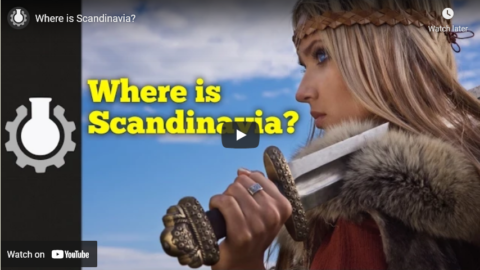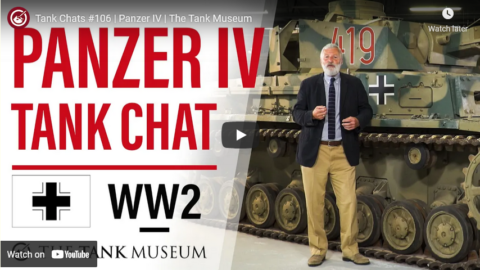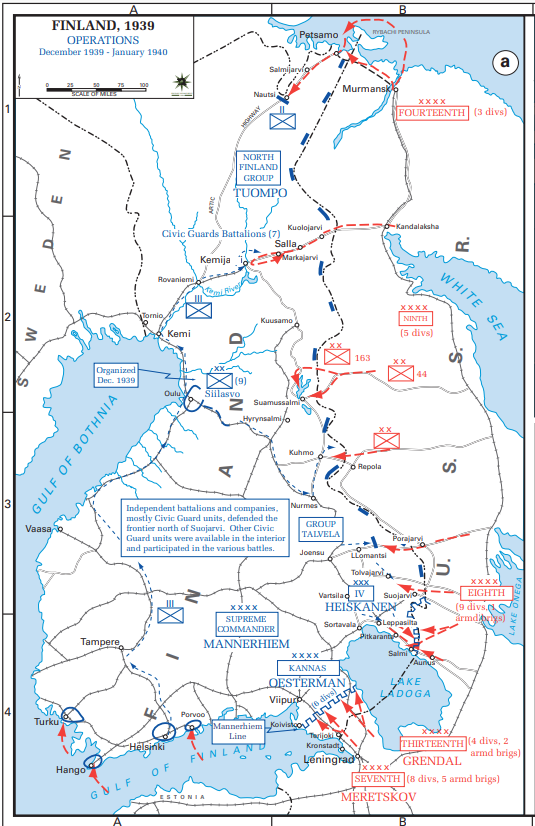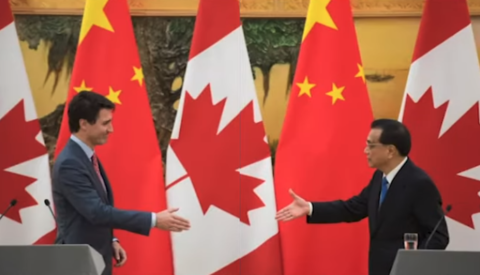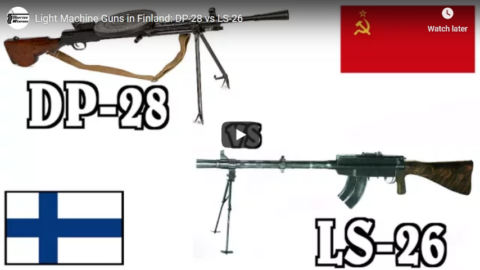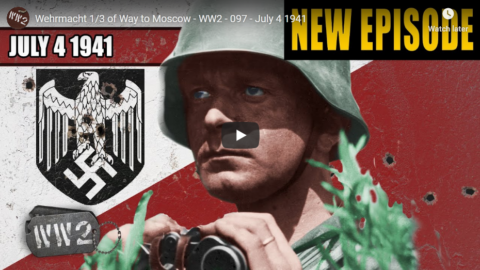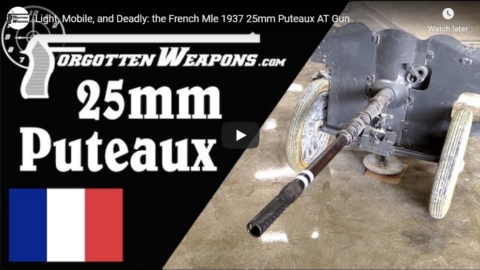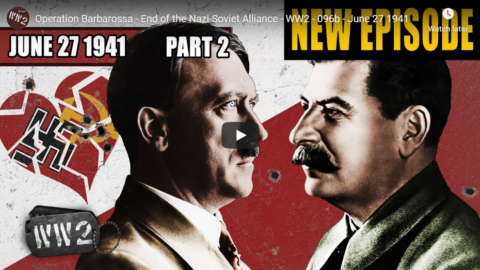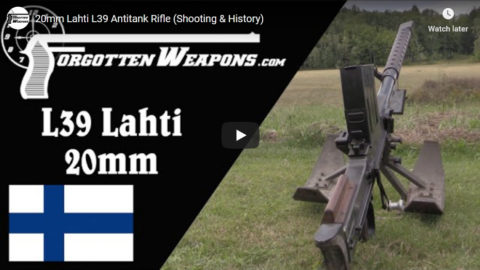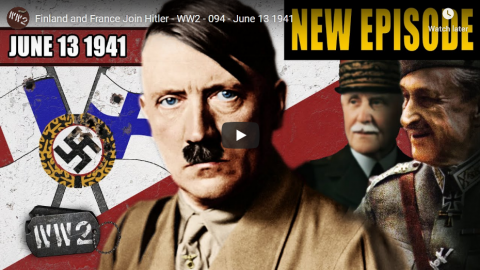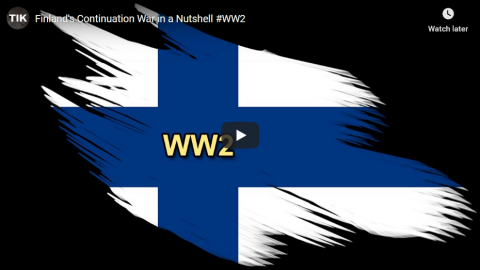CGP Grey
Published 25 Mar 2015Grey Merch: https://cgpgrey.com/merch
Grey on Twitter: https://twitter.com/cgpgrey
May 23, 2021
Where is Scandinavia?
May 7, 2021
Tank Chats #106 | Panzer IV | The Tank Museum
The Tank Museum
Published 11 Sep 2020Join The Tank Museum’s Curator David Willey as he discusses the Sd.Kfz 161, better known as Panzer IV: the most numerously produced tank by Germany during the Second World War.
Support the work of The Tank Museum on Patreon: ► https://www.patreon.com/tankmuseum
Visit The Tank Museum SHOP & become a Friend: ► tankmuseumshop.orgTwitter: ► https://twitter.com/TankMuseum
Instagram: ► https://www.instagram.com/tankmuseum/
#tankmuseum #tanks
April 22, 2021
The Winter War
In Quillette, Sean McMeekin outlines the disaster of the first Soviet offensive against Finland in the opening battles of the 1939-40 Winter War:
While Finland, with a tiny population of scarcely 3.5 million, could hardly have threatened the Soviet colossus, it had fought fiercely for independence during the Russian Civil War, conquering Helsinki in April 1918 and dealing the Reds a series of painful blows. The Finnish White Guards — as the Bolsheviks referred to the forces then commanded by the redoubtable Gustaf Mannerheim — had also, Stalin remembered, worked with German troops and collaborated with the British Baltic fleet. Had Mannerheim’s connections with the Germans not been so strong, the British might have lent his Finnish guards more support in the critical days of fall 1919, when Petrograd nearly fell to the Whites. But this was small consolation to Stalin, who mostly remembered the humiliation of losing Finland and Finnish double-dealing with outside powers. The fear that Finland might once again invite in a power hostile to the USSR, whether Britain or Germany, was never far from Stalin’s mind.
When Molotov summoned a Finnish delegation to the Kremlin on October 12th, 1939, Stalin made a personal appearance to heighten the intimidation factor, and he handed the Finns a brutal ultimatum demanding, among other things, “that the frontier between Russia and Finland in the Karelian Isthmus region be moved westward to a point only 20 miles east of Viipuri, and that all existing fortifications on the Karelian Isthmus be destroyed.” Stalin made it clear that this was the price that Finland had to pay to avoid the fate of Poland.
Aggressive and insulting as the Soviet demands on Finland were, Stalin and Molotov fully expected them to be accepted. As the Ukrainian party boss and future general secretary Nikita Khrushchev later recalled, the mood in the Politburo at the time was that “all we had to do was raise our voice a little bit and the Finns would obey. If that didn’t work, we could fire one shot and the Finns would put up their hands and surrender.” Stalin ruled, after all, a heavily armed empire of more than 170 million that had been in a state of near-constant mobilization since early September. The Red Army had already deployed 21,000 modern tanks, while the tiny Finnish Army did not possess an anti-tank gun. The Finnish Air Force had maybe a dozen fighter planes, facing a Red Air armada of 15,000, with 10,362 brand-new warplanes built in 1939 alone. Finnish Army reserves still mostly drilled with wooden rifles dating to the 19th century. By contrast, the Red Army was, in late 1939, the largest in the world, the most mechanized, the most heavily armored, and the most lavishly armed, even if surely not — because of Stalin’s purges — the best led.
[…]
Just past dawn on November 30th, Stalin’s undeclared war against Finland began with a furious artillery barrage on all fronts, followed by the scream of warplanes overhead. The only difference between the bald acts of territorial aggression in Finland and Poland was that the Soviet blitzkrieg was less efficient. Soviet medium bombers — mostly SB-2s cautiously dropping one-ton payloads from heights of 3,000 feet or more — weren’t especially accurate. In Helsinki, Russian bombers failed to knock out a single docking bay, airfield runway, Finnish warplane, or oil tank (although one airport hangar was destroyed). A stray bomb hit the Soviet legation building. According to eyewitnesses, Red fighter pilots strafed Helsinki suburbs as well, “machine-gunning women and children who had fled their houses to the fields.” Similar scenes of horror were repeated in Viipuri (Vyborg), as well as in provincial towns such as Lahti, Enso, and Kotka.
Meretskov’s landward assault on the Karelian Isthmus fared poorly. During the interval between the border incident of November 26th and the Russian onslaught early on November 30th, Mannerheim had wisely evacuated most of the civilian population. A series of clever booby traps were set for the invaders, including “pipe mines” — steel tubes crammed with explosives buried in snowdrifts and set off by hidden trip wires. The most effective defense of all was the Molotov cocktail, first used in Spain but ingeniously updated by the Finns, who would fill liquor bottles with a blend of gasoline or kerosene, tar, and potassium chloride. In fits of derring-do, Finnish soldiers on skis would drop these into the turrets of advancing tanks, ram branches or crowbars into the tank treads, or slice holes in the ice to sink them. Despite boasts in the Russian high command that the campaign would be over in 12 days, by mid-December, most of the Soviet Seventh and Thirteenth Armies were still blundering along short of the Mannerheim Line. On December 17th, in fact, the Thirteenth Army actually went into reverse, retreating after bloody losses in a clash at Taipale. By then, even the tiny Finnish Air Force of old Dutch Fokker fighters had joined the rout, knocking down Soviet bombers — one Finnish ace took out six in four minutes — and doing wonders for the morale of the Finns below. Further north, the Soviet Ninth Army was nearly destroyed in a battle near a burned-out Suomussalmi on December 9th. One Finnish ski sniper, a farmer named Simo Häyhä, personally killed, according to (improbable) legend, more than 500 Russians[*]. Wounded Russians overwhelmed the hospitals of Leningrad. One overworked Soviet surgeon complained in early December that he was dealing with nearly 400 wounded Red Army soldiers every day.
* The story of Simo Häyhä was set to music by Sabaton in their song “White Death” on the Coat of Arms album. Indy Neidell discussed the history behind the music in a Sabaton History video in 2019.
March 24, 2021
“By now it has dawned on even the most glossy-eyed internationalists that we are well into another sides-picking era of global geopolitics”
Like it or not, we’re already a few years into a new Cold War, this time with the Chinese Communist Party. The Canadian government seems to be among the last in the world to recognize this change in the geopolitical situation. In The Line, Andrew Potter shows why Justin Trudeau must stop trying to cuddle up to Xi:
The outrageous secret trials in China of Michael Spavor last Friday and Michael Kovrig this Monday are nothing more than punctuation marks on a storyline that has been obvious for some time now.
Which is why it was enormously gratifying to see more than two dozen diplomats show up to seek admittance to Kovrig’s trial. The fact that none was admitted is unfortunate but largely beside the point — what matters is the public display of solidarity. Even more gratifying perhaps is the announcement (by Canadian officials) that the U.S. has promised to treat the two Canadians as if they were American citizens. After all, it was our acquiescence to a U.S. request to arrest Huawei executive Meng Wanzhou at Vancouver International Airport in 2018 that prompted Beijing to nab Spavor and Kovrig in retaliation. While Chinese officials have denied that what this amounts to is hostage diplomacy, they’ve also made it clear that the fate of the Michaels is tied to that of Meng.
What makes the public support from all of these countries so remarkable is that a lot of them — the Czechs, the Finns, the Romanians — have very little to gain from sticking their neck out for Canada. More to the point, every one of these countries has good reason to wonder just how committed Canada itself is to this show of collective strength. After all, it was only five years ago that senior members of the Liberal party were freely — privately, but freely — saying that as far as the Liberal government was concerned, the U.S. was yesterday’s news and China was the horse Canada was going to ride into the future.
And while a lot has changed over the last five years (not least of which is the fact that Donald Trump has come and gone as president of the United States), it remains incomprehensible that it was just last year the Canadian National Research Council placed its disastrous COVID-19 vaccine bet with CanSino Biologics, a Chinese company with close ties to the Chinese military. What are our allies to make of the fact that only last month, the federal granting agency NSERC partnered with Huawei to sponsor computer engineering at Canadian universities. Or that Canada’s visa office in Beijing is owned and staffed by a Chinese police force?
Whether it is a matter of naïveté, bad faith, or outright cravenness, Canada continues to give every indication that it is a country that is still hedging its bets.
March 22, 2021
Apocrypha: Tour of the Kyrö Distillery
Forgotten Weapons
Published 21 Mar 2021While I was in Finland for Finnish Brutality 2021, I took a day to hitch a train ride up to Isokyrö, about 400km northwest of Helsinki. The Kyrö distillery was founded there in 2012, making single malt Finnish rye whiskey and several varieties of gin.
Their own video does a fine job describing the origins of the distillery:
But I wanted to get a look at the production process — and it’s impressively well set up! The rye is made in a pair of imported Scottish pot stills, and the gin uses a combination of pot and column distillation. They were kind enough to give me a tour of the whole place, so let’s have a look around!
They are distributed throughout the EU, and to a limited extent in the US.
(Apocrypha is a behind-the-scenes periodic series normally only available to Patreon supporters of Forgotten Weapons. Want to see more? Sign up to help support me directly at http://www.patreon.com/forgottenweapons)
February 10, 2021
One Advantage of Swiss Neutrality: LSD! – WW2 – Reading Comments
World War Two
Published 9 Feb 2021Another edition of Across the Airwaves, where Indy and Sparty look at interesting and unique comments from our videos. In this episode, they look at gentlemanly declarations of war, Partisan memories, and LSD.
Join us on Patreon: https://www.patreon.com/TimeGhostHistory
Or join The TimeGhost Army directly at: https://timeghost.tvFollow WW2 day by day on Instagram @ww2_day_by_day – https://www.instagram.com/ww2_day_by_day
Between 2 Wars: https://www.youtube.com/playlist?list…
Source list: http://bit.ly/WW2sourcesHosted by: Indy Neidell & Spartacus Olsson
Director: Astrid Deinhard
Producers: Astrid Deinhard and Spartacus Olsson
Executive Producers: Astrid Deinhard, Indy Neidell, Spartacus Olsson, Bodo Rittenauer
Creative Producer: Maria Kyhle
Post-Production Director: Wieke Kapteijns
Edited by: Karolina Dołęga
Sound design: Marek Kamiński
Map animations: Eastory (https://www.youtube.com/c/eastory)Colorizations by:
– Daniel Weiss
– Mikołaj Uchman
– JHM Color
– Julius Jääskeläinen – https://www.facebook.com/JJcolorization/Sources:
– Imperial War Museums: MH 1324, CH 1533, HU111054, TR 1468, MGH 4464
– National Archives NARA
– United States Holocaust Memorial Museum
– Yad Vashem: 4360-99, 2725-5, 4788-73,
– Bundesarchiv
– Picture of Soviet Soldiers with DShK-38 gun courtesy of Leduytoan2003 from Wikimedia Commons
– Picture of 19th Army troops storming Mogile courtesy of Mil.ruSoundtracks from Epidemic Sound:
– “The Unexplored” – Philip Ayers
– “The Inspector 4” – Johannes Bornlöf
– “London” – Howard Harper-Barnes
– “Document This 1” – Peter Sandberg
– “Dark Beginning” – Johan Hynynen
– “Rubik’s Cube” – From Now On
– “Getaway Rock” – Elliot HolmesArchive by Screenocean/Reuters https://www.screenocean.com.
A TimeGhost chronological documentary produced by OnLion Entertainment GmbH.
January 10, 2021
Light Machine Guns in Finland: DP-28 vs LS-26
Forgotten Weapons
Published 20 Jul 2017http://www.patreon.com/ForgottenWeapons
Before the Winter War, the standard light machine gun adopted by the Finnish military was the Lahti-Saloranta LS-26. This was a complex and finely built weapon, using a short recoil action and tilting bolt, chambered for the same 7.62x54mm rimmed cartridge as used by Finland’s Mosin-Nagant infantry rifles. The LS-26 fed from 20-round box magazines which are a bit unusual in having a single-feed presentation (which made them difficult to load without a tool, but also prevented potential problems from rimlock).
In total, about 5,000 LS26 machine guns were made for Finland (and an additional 1,200 sold to China in 8mm Mauser). They were apparently quite accurate, but highly prone to malfunctioning in the cold and dirty field conditions of Finnish combat. When the Winter War broke out and Finns began capturing Russian equipment, the Russian DP-28 light machine gun became a very popular alternative to the LS-26.
The Degtyarev DP-28 may not have been as refined of a weapon, but it was much better suited to real combat. It was simple and reliable, and the 47-round magazine capacity was certainly appreciated as well. By the end of the Continuation War, Finland had some 15,000 Degtyarev light machine guns in its inventory, far outnumbering the LS-26s.
Today Karl and I had a chance to fire both weapons side by side (unfortunately, my trigger time on the LS-26 was quite limited, and I was not able to film a full disassembly of it). We both found the LS-26 to be quite a challenging weapon to use effectively, even without any malfunctions. The Degtyarev was a much more usable machine gun.
One other interesting takeaway for us was the remarkable effectiveness of the semiautomatics DP/DPM made by SMG Guns here in the US. It delivered probably 90% of the utility of the original fully automatic version, which is quite impressive. After this comparison, I would recommend it even more heartily than before.
Special thanks to Varusteleka for arranging this shoot!
All photos in this video are courtesy of the excellent Finnish Defense Forces’ Photo Archive:
http://sa-kuva.fiCool Forgotten Weapons merch! http://shop.bbtv.com/collections/forg…
If you enjoy Forgotten Weapons, check out its sister channel, InRangeTV! http://www.youtube.com/InRangeTVShow
September 6, 2020
July 5, 2020
Light, Mobile, and Deadly: the French Mle 1937 25mm Puteaux AT Gun
Forgotten Weapons
Published 20 Mar 2020http://www.patreon.com/ForgottenWeapons
https://www.floatplane.com/channel/Fo…
Cool Forgotten Weapons merch! http://shop.bbtv.com/collections/forg…
After World War One, the French military set up a program to modernize all of its weaponry, and that included a replacement for the Mle 1916 light infantry cannon. An anti-tank gun had not been necessary during the Great War, as Germany never fielded tanks in substantial numbers — but as a pioneer of the modern tank, the French recognized the need for a good AT gun. Taking a lesson from World War One, they wanted a light gun that was flexible and mobile, easily moved around the battlefield and easily concealed from enemy fire. A 25mm cartridge was specified, and both the Hotchkiss company and the Puteaux arsenal created guns to use it. Both were adopted into service, with the Hotchkiss Mle 1934 being a bit heavier and the Puteaux Mle 1937 being a bit lighter, at only about 600 pounds. The Puteaux gun was quite small, easily moved by a horse or virtually any motorized vehicle. It had a long barrel and the 25mm AP projectile had a muzzle velocity of about 3150 fps, making it quite effective on the light and medium tanks of the 1930s. It was also remarkably accurate, and the long barrel and flash hider gave it a very small firing signature. Aiming was done with either a 4x magnified optic or a set of backup iron sights.
A total of 1285 of these guns were made before the armistice of June 1940, and they served ably in the Battle of France. A few were also used by the British before Dunkirk, and after the armistice they were used by German forces in limited numbers, and also supplied to Spain and Finland as military aid (this particular one has a Finnish property tag on it).
Thanks to DriveTanks.com in Uvalde Texas for giving me access to film this Puteaux cannon for you!
Contact:
Forgotten Weapons
6281 N. Oracle #36270
Tucson, AZ 85740
June 28, 2020
June 25, 2020
20mm Lahti L39 Antitank Rifle (Shooting & History)
Forgotten Weapons
Published 12 Sep 2016Sold for $10,350.
The Lahti L39 was the Finnish answer to the need for an anti-tank rifle, developed just before the Winter War. The rifle was created by noted Finnish designed Aimo Lahti, who had pressed for it to use a 13.2mm cartridge. However, arguments for using a 20x138B cartridge won out, based on hopes to use that cartridge in both antitank and antiaircraft roles, as well as testing that showed the 20mm projectile to have greater terminal effect.
The L39 was not available for use in the Winter War (having been adopted barely 2 months before the Russian attack), but was used extensively in the Continuation War. While improved tank armor quickly became thick enough to protect against the round, it was used for a variety of anti material roles, attacking machine gun positions, bunkers, light vehicles, and more. In 1944, an anti-aircraft version was also produced, firing in full auto and using 15-round magazines.
Today, ammunition is available from a few companies, typically using lathe-turned new cases and surplus 20mm Vulcan projectiles.
June 14, 2020
May 19, 2020
The Battle of Tali-Ihantala 1944
TIK
Published 18 May 2020The Battle of Tali-Ihantala narrated with unit movements over a map, backed by sources (listed in the description).
In 1944 The Red Army of the Soviet Union attacked the Finnish Army on the VKT Line during the Continuation War, resulting in the Battle of Tali-Ihantala. Here are the major unit movements during the battle and a discussion regarding the statistics and the interpretation of the battle. #WW2 #ContinuationWar
Videos EVERY Monday at 5pm GMT (depending on season, check for British Summer Time).
Want to ask a question? Please consider supporting me on either Patreon or SubscribeStar and help make more videos like this possible. For $5 or more you can ask questions which I will answer in future Q&A videos. Thank you to my current Patrons! You’re AWESOME! https://www.patreon.com/TIKhistory or https://www.subscribestar.com/tikhistory
– – – – –
BIBLIOGRAPHY / SOURCES
The main sources used for this video –
Lunde, H. Finland’s War of Choice: The Troubled German-Finnish Coalition in World War II. Casemate Publishers, 2011.
Nenye, V. Finland at War: The Continuation and Lapland Wars 1941-45. Osprey Publishing, Kindle 2016.
And (unfortunately) also wikipedia – https://en.wikipedia.org/wiki/Battle_of_Tali-IhantalaFull list of all my sources https://docs.google.com/spreadsheets/…

